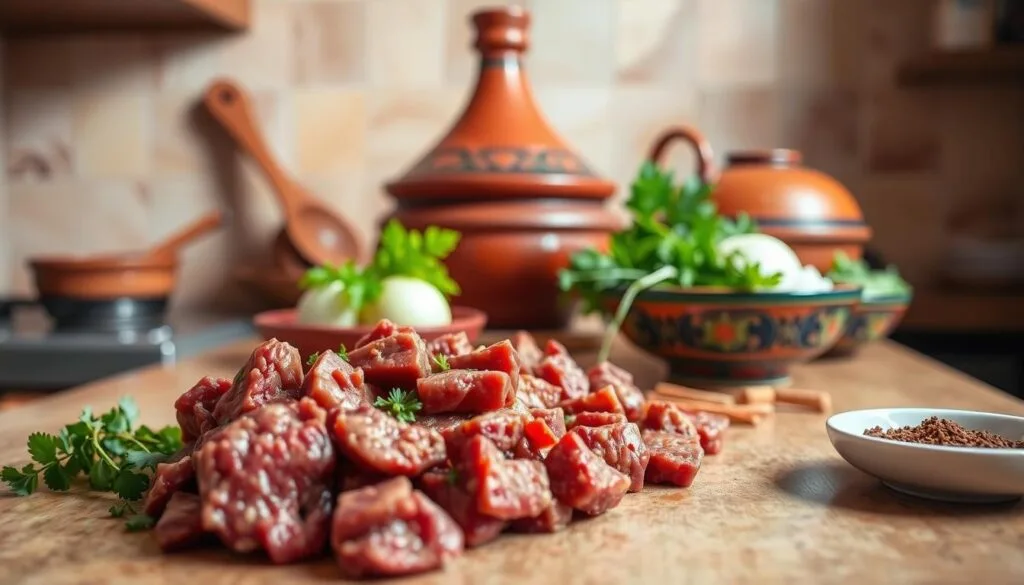Imagine a dish so rich and aromatic that it transports you to the bustling markets of North Africa. Moroccan Beef Tagine is more than just a meal; it’s an experience. This traditional slow-cooked stew is a labor of love, blending tender beef, vibrant spices, and a medley of vegetables in a harmonious balance of flavors. With its deep, comforting aroma and hearty texture, this recipe is sure to become a favorite in your kitchen.
At the heart of this dish is the tagine pot, a clay vessel with a conical lid designed to capture and redistribute condensation, ensuring every bite is infused with moisture and flavor. While a Dutch oven can serve as a modern alternative, the traditional pot adds an authentic touch to your cooking experience. The slow simmering process tenderizes the beef, melds the spices, and creates a sauce so flavorful, you’ll want to savor every drop.
This recipe is a celebration of North African cuisine, offering a perfect blend of warmth and exotic flair. From the first sizzle of onions to the final sprinkle of cilantro, every step is a testament to the rich culinary traditions of Morocco. Whether you’re serving it with couscous, rice, or crusty bread, this dish promises to bring a taste of Morocco right to your table.
Table of Contents
Introduction to Moroccan Beef Tagine
Step into the heart of North African cuisine with the iconic Moroccan Beef Tagine, a dish that embodies centuries of cultural richness. This slow-cooked stew is more than a meal—it’s a tradition that connects people to Morocco’s culinary heritage.
Discovering the Rich History and Traditions
Originating in Morocco, the tagine is both a cooking vessel and a symbol of hospitality. Its conical lid captures steam, allowing it to circulate back into the pot, ensuring tender meat and flavorful sauces. This design reflects the resourcefulness of Moroccan cooks, who optimized moisture retention without needing large amounts of water.
What Makes This North African Dish Unique?
The tagine’s uniqueness lies in its blend of aromatic spices like cinnamon, ginger, and turmeric, which infuse the beef and vegetables with depth. The layering of ingredients—meat, onions, and spices—follows a culinary philosophy that values balance and harmony. This method, passed down through generations, ensures each bite is a testament to Morocco’s rich traditions.
| Feature | Details |
|---|---|
| Tagine Pot | A clay vessel with a conical lid for steam circulation. |
| Cooking Time | Approximately 2 hours for tender beef. |
| Key Spices | Cinnamon, cumin, turmeric, and ginger. |
| Ingredients | Beef, onions, garlic, and a variety of vegetables. |
This guide offers a comprehensive introduction to Moroccan Beef Tagine, perfect for home cooks eager to explore North African flavors. By understanding its history and techniques, you’ll appreciate the cultural richness behind this beloved dish and be inspired to create your own authentic version.
Essential Ingredients for a Delicious Tagine
To craft an authentic tagine, you need the right ingredients. Each component plays a vital role in creating that signature flavor profile.
Selecting the Perfect Cut of Beef
For a tender and flavorful tagine, choose a high-quality cut of beef. Chuck roast is ideal because it becomes melt-in-your-mouth tender when slow-cooked. This cut absorbs the rich spices and aromatics beautifully, making every bite a delight.
Layering Aromatics, Spices, and Vegetables
The foundation of your tagine starts with sautéed onions, garlic, and ginger. These aromatics create a flavorful base. Next, add your spice blend, which typically includes paprika, cumin, coriander, and cinnamon, to infuse depth into the dish.
Layer in vegetables like carrots and potatoes, along with garbanzo beans for texture. A touch of tomato paste and diced tomatoes adds acidity and moisture. For sweetness, dried apricots and raisins provide a delightful contrast to the savory spices.
| Ingredient | Details |
|---|---|
| Beef | Chuck roast for tender results |
| Aromatics | Onions, garlic, and ginger |
| Spices | Paprika, cumin, coriander, cinnamon |
| Vegetables | Carrots, potatoes, garbanzo beans |
| Additional Flavors | Dried apricots and raisins |
Each ingredient is carefully chosen to enhance the natural flavors, creating a harmonious and authentic tagine experience.
Step-by-Step Guide to Preparing Your Tagine
Preparing a delicious tagine involves careful preparation of ingredients and a well-crafted spice rub. This step-by-step guide will walk you through the process, ensuring your dish turns out flavorful and authentic.
Prepping Your Ingredients and Spice Rub
Start by gathering all your ingredients. Chop the onions, mince the garlic, and grate the ginger. These aromatics form the base of your tagine’s flavor profile.
Next, prepare the spice rub. In a small bowl, mix together 1 teaspoon of salt, 1 teaspoon of black pepper, 1 teaspoon of paprika, 1 teaspoon of cumin, 1 teaspoon of coriander, and a pinch of cinnamon. This blend will season your beef evenly, enhancing its natural taste.
Coat the beef chuck roast with the spice rub, ensuring every piece is well-covered. Let it marinate for at least 30 minutes to allow the flavors to penetrate the meat.
Heat 2 tablespoons of olive oil in your tagine pot or Dutch oven over medium heat. Sear the beef in batches for about 10 minutes, ensuring a nice brown crust forms on each piece. This step locks in the beef’s juices and adds depth to your dish.
After browning the beef, add the chopped onions, garlic, and ginger to the pot. Sauté until the onions are translucent and fragrant, about 5 minutes. This step softens the aromatics and releases their flavors.
Stir in 1 tablespoon of tomato paste and let it cook for 2-3 minutes, allowing it to caramelize slightly. This adds a rich, tangy flavor to your tagine. Deglaze the pot by scraping the bottom to incorporate all the browned bits.
Add 1 cup of beef broth and 1 cup of diced tomatoes to the pot, stirring to combine. Bring the mixture to a simmer, then reduce the heat to low. Cover the pot with a lid and let it cook for 1.5 to 2 hours, or until the beef is tender and the sauce has thickened.
As the tagine cooks, prepare your workstation. Ensure all utensils and serving dishes are ready for a smooth service once the dish is done.
Remember, patience is key. Each step builds upon the last, creating a robust and balanced flavor profile. Searing the meat and sautéing the aromatics lay the groundwork for a hearty stew.

By following these steps, you’ll achieve a perfectly prepared tagine that’s both flavorful and authentic. Enjoy the process and the delightful meal that follows!
Cooking Techniques and Tips for Perfect Results
Mastering the art of cooking a delicious tagine requires attention to detail and the right techniques. Whether you’re using a traditional tagine pot or a Dutch oven, these tips will guide you to a perfectly cooked dish.
Searing Meat and Building Flavor
Achieve a perfect sear on your beef by browning it evenly on all sides. This step is crucial as it locks in the juices and adds depth to your dish. Use a heavy-bottomed pot or tagine pot to maintain consistent heat during simmering.
After searing, reduce the heat to low and cover the pot with a lid. This allows moisture to recirculate, ensuring tender meat and rich flavors. Stir occasionally to prevent sticking and distribute spices evenly.
Simmering Techniques for Tender Beef
Simmering is where the magic happens. A Dutch oven can reduce cooking time, but traditional tagine pots offer authentic moisture circulation. Balance low heat with extended simmering to let spices infuse without drying the meat.
If the sauce thickens too much, add a bit more stock or water. Patience is key—let the beef cook slowly until tender. Adjust salt and pepper as needed for the perfect seasoning.
| Technique | Details |
|---|---|
| Searing | Brown beef evenly on all sides for locked-in flavor |
| Simmering | Low heat with lid for moisture retention |
| Stirring | Stir occasionally to prevent sticking |

By following these techniques, you’ll craft a tagine that’s both flavorful and tender. Remember, precise temperature control and patient simmering are essential for a deliciously authentic dish.
Cooking Your Moroccan Beef Tagine to Perfection
Cooking a perfect tagine is all about the vessel you choose. Whether you opt for a traditional tagine pot or a Dutch oven, the result is a dish brimming with flavor and tenderness.
Using a Tagine Pot Versus a Dutch Oven
A traditional tagine pot is designed with a conical lid that captures steam, circulating it back into the dish. This unique feature ensures the meat stays moist and the flavors are evenly distributed. While authentic, it requires some practice to master the heat distribution.
A Dutch oven, on the other hand, offers a more accessible alternative. Its thick walls and tight-fitting lid allow for excellent heat retention, simulating the slow-cooking environment of a tagine pot. This makes it ideal for those who want to achieve similar results without investing in a traditional vessel.
- Tagine Pot: Ideal for traditional steam circulation and authentic presentation.
- Dutch Oven: Versatile and easier to find, perfect for slow-cooking with consistent results.
Both methods require low heat and a covered lid to develop the rich sauce and tender beef. The choice between them comes down to availability and personal preference. Either way, you’ll end up with a hearty, flavorful dish that captures the essence of Moroccan cuisine.
Experiment with either vessel to find your perfect method. The end result will be nothing short of extraordinary—a deliciously authentic Moroccan Beef Tagine that your family and friends will love.
Serving Suggestions and Side Dish Ideas
When it comes to serving your beef tagine, the presentation and accompaniments can elevate the dining experience. This hearty stew is a versatile dish that pairs well with various sides, allowing you to create a meal that suits your taste preferences.
A traditional approach is to serve the beef tagine directly from the pot, which adds an authentic touch. For a more formal setting, consider transferring it to a large serving dish or individual plates. The goal is to enhance every bite with complementary textures and flavors.
Pairing Suggestions:
- Serve over a bed of fluffy couscous to soak up the rich sauce.
- Accompany with warm rice or crusty bread for a satisfying contrast.
- Offer refreshing side salads, like a light couscous salad or a traditional Moroccan bread called khobz, for a balanced meal.
Garnishing your beef tagine with slivered almonds, chopped cilantro, and a squeeze of lemon will brighten the flavors and add a fresh finish. These touches not only enhance the taste but also make the dish visually appealing.
Experiment with different side combinations to match your mood. Whether served family-style in the pot or plated individually, the beef tagine promises a delightful experience. Leftovers are a bonus, as the flavors meld further, and the dish can be gently reheated for future meals.
“The art of serving is an extension of the cooking process, where every element contributes to a memorable experience.”
For those looking for more ideas, you can explore other tagine recipes to find inspiration for complementary sides and salads. This ensures your meal is both authentic and enjoyable.
Conclusion
Creating an authentic beef tagine is a rewarding journey that combines rich flavors, tender meat, and aromatic spices. This traditional North African dish is a testament to slow-cooking perfection, where every ingredient melds together in harmony. The result is a hearty, comforting meal that captures the essence of Moroccan cuisine.
By following the step-by-step guide, you’ve learned how to select the finest ingredients, from the chuck roast to the blend of spices, and how to layer them for maximum flavor. The slow simmering process ensures the beef is tender, while the spices infuse a deep, aromatic taste. Whether you use a traditional tagine pot or a Dutch oven, the outcome is a dish that’s both authentic and delicious.
This recipe stays true to Moroccan traditions, avoiding non-traditional ingredients like wine or pork. It’s a celebration of simplicity and depth, offering a meal that’s both nourishing and flavorful. With its rich sauce and tender beef, this tagine is sure to become a favorite in your kitchen.
Don’t hesitate to experiment with side dishes or share your cooking experience. Your feedback is invaluable, and we’d love to hear how your tagine turned out. Thank you for joining us on this culinary adventure. Give this recipe a try and enjoy the delightful, slow-cooked flavors of a traditional beef tagine!

